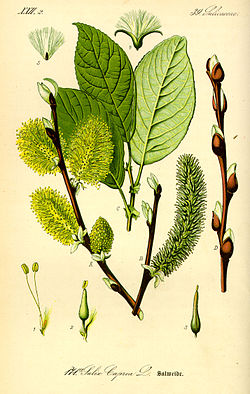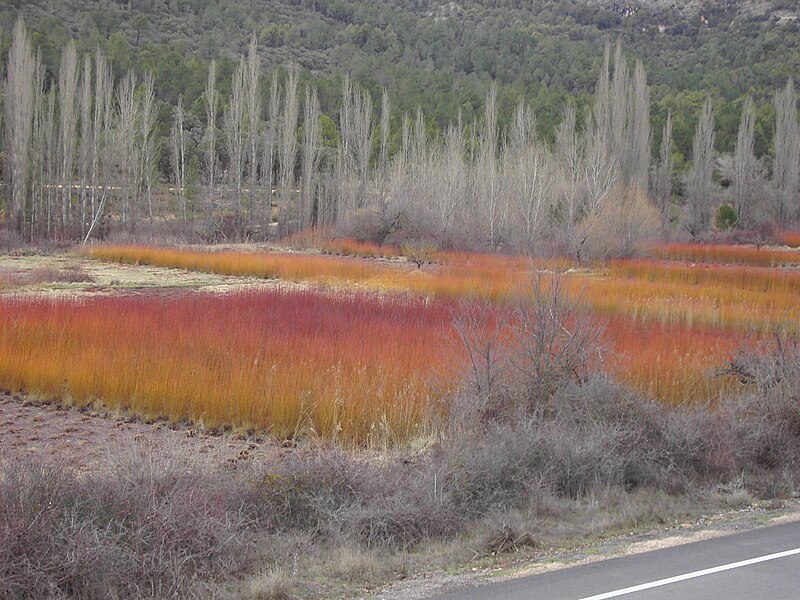Sauce
Salix vim
Plantío de sauce en Cañamares, España
| Sauces | |
|---|---|
 Salix caprea |
|
| Clasificación científica | |
| Reino: | Plantae |
| División: | Magnoliophyta |
| Clase: | Magnoliopsida |
| Orden: | Malpighiales |
| Familia: | Salicaceae |
| Género: | Salix L. |
| Especies | |
Se distribuyen por las zonas frías y templadas del Hemisferio Norte, principalmente en tierras húmedas. Algunas especies, en especial las árticas y alpinas son arbustos de crecimiento bajo o rastrero, como el sauce que Carlos Linneo consideró el árbol más pequeño del mundo Salix herbacea que no supera los 6 cm de altura aunque se extiende profusamente por el suelo.
Otras, como el sauce negro norteamericano (Salix nigra) puede medir 35 m. Aunque el más conocido es sin duda el sauce llorón o sauce de Babilonia (S. babylonica) nativo de China, con ramas finas y elásticas pobladas por numerosísimas hojas doradas y pequeñas. Es un árbol de talla media dentro de la familia, llegando este a medir entre 8 y 12 metros.
La fertilización cruzada es muy frecuente entre los miembros del género, por lo que se dan numerosos híbridos, tanto de forma natural como en cultivo.
Todos los sauces tienen la corteza acuosa; la madera es dura, flexible y normalmente suave. Poseen esbeltas y fibrosas ramas y a menudo raíces estoloníferas, cuyas características más notables son su dureza, largura y resistencia. También desarrollan fácilmente raíces aéreas.
Las hojas son típicamente elongadas, aunque también pueden ser redondas u ovales, con frecuencia de bordes serrados. La mayoría de las especies son caducifolias o semiperennes.
Son plantas dioicas (flores masculinas y femeninas en diferentes plantas). Los amentos surgen a principios de la primavera, a menudo antes que las hojas o al mismo tiempo.
Su uso es principalmente orientado a la jardinería ornamental pero podemos encontrar otras especies como el sauce cabruno (Salix caprea) cuyos brotes son una exquisitez para las cabras o la mimbrera (Salix fragilis) cuyo uso para realizar cierres de fincas se compatibiliza con la ideonidad de sus ramas para la cestería.
Usos medicinales
La corteza de sauce ha sido mencionada en antiguos textos de Asiria, Sumeria y Egipto como un remedio contra los dolores y fiebre y el médico griego Hipócrates escribió acerca de sus propiedades medicinales hacia el siglo V a. C.
Los indígenas americanos centraron en ella la base de sus tratamientos médicos.
El extracto activo de la corteza llamado salicina, fue aislado en su forma cristalina en 1828 por Henry Leroux, –un farmacéutico francés– y Raffaele Piria –un químico italiano– quien entonces tuvo éxito en separar el ácido en su estado puro, la salicina es ácida en una solución saturada en agua, y es llamada ácido salicílico por esa razón. En 1897 Felix Hoffman crea una versión sintéticamente alterada (en este caso derivada de la planta Spiraea) que era menos problemática para la digestión que el ácido salicílico puro. La nueva sustancia, ácido acetil-salicílico fue nombrada aspirina por la empresa farmacéutica Bayer AG. Esto le dio una gran importancia al clasificarse como medicamento no esteroideo antiinflamatorio.
=============================
Wicker is hard woven fiber formed into a rigid material, usually used for baskets or furniture.[1] Wicker is often made of material of plant origin, but plastic fibers are also used.
Materials used can be any part of a plant, such as the cores of cane or rattan stalks, or whole thicknesses of plants, as with willow switches. Other popular materials include reed and bamboo.
Often a frame is made of stiffer materials, after which more pliant material is used to fill in the frame. Wicker is light yet sturdy, making it suitable for furniture that will be moved often. It is often used for porch and patio furniture.[2]
Wicker furniture has been documented as far back as ancient Egypt,[3] that was considered to be one of the ideal elements of modern outdoor furniture. It was the first natural material to be used for furniture, starting out as baskets and chairs. The history of wicker furniture was revealed when archaeologists discovered dozens of wicker furniture items made from reed and swamp grasses (Saunders 1990) while working to uncover the civilizations of the Pharaohs.[4]
The popularity of wicker furniture was passed from Egypt to Rome and throughout Europe as international sea traders carried the materials to Great Britain, Portugal, and Spain, and wicker baskets have been found in Pompeii.[5] The popularity of wicker in America, however, was another story as its popularity did not rise until the mid-nineteenth century. It was Cyrus Wakefield who had discovered large quantities of rattan, the most common material for wicker furniture, and began construction of his own line of wicker furniture. That soon caught the attention of the population and made his company one of the leading industries in wicker furniture.[6] It has been proposed that the extensive use of wicker objects in the Iron Age had an influence on the development of the patterns used in Celtic art.[citation needed] In recent times, its aesthetic was influenced heavily by the Arts and Crafts movement at the turn of the 20th century.
The oldest and most prominent North American manufacturer was Heywood-Wakefield of Gardner, Massachusetts. Antique wicker products are highly sought after by collectors.
There are two types of wicker furniture available — natural and synthetic. Natural wicker is well known for its strength and durability, and for the high level of beauty and comfort that an expert craftsman can produce. Natural wicker requires maintenance to keep it in good shape. Synthetic types include paper-wrapped high tensile wire (using the Lloyd Loom process patented in the early 1900s), and plastic or resin and are often preferred for outdoor use.
Etymology
The word wicker is from the Middle English wiker, of Scandinavian origin.[7]
DIY
http://www.ehow.com/wicker-furniture/
http://www.wickerwoman.com/
http://casa-hogar.org/category/cestas-de-mimbre


No comments:
Post a Comment